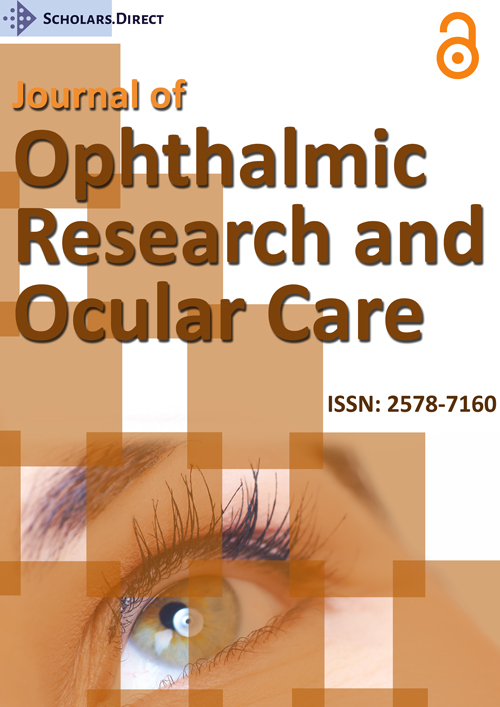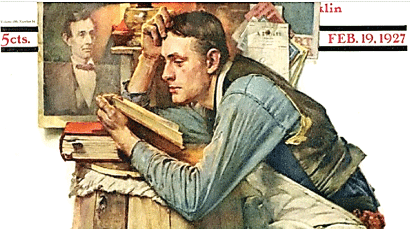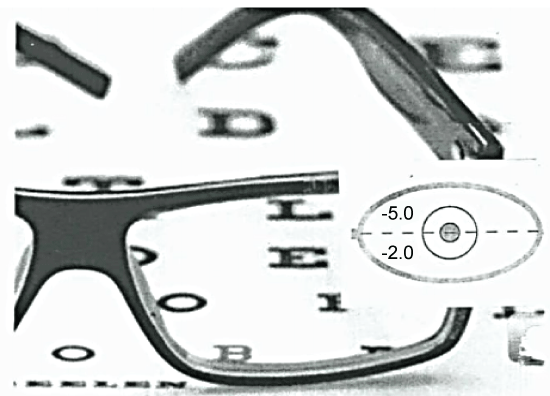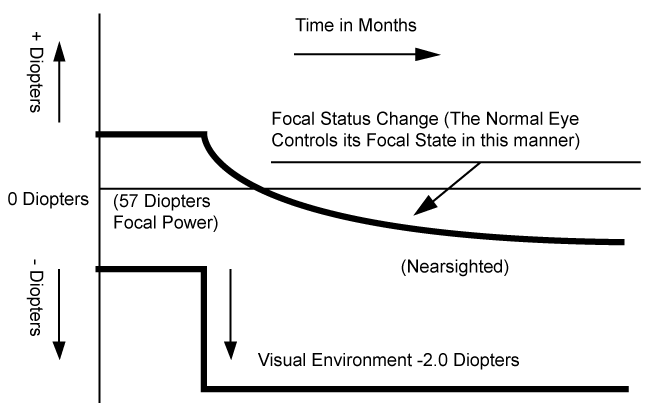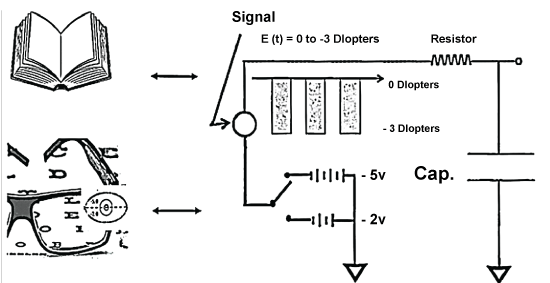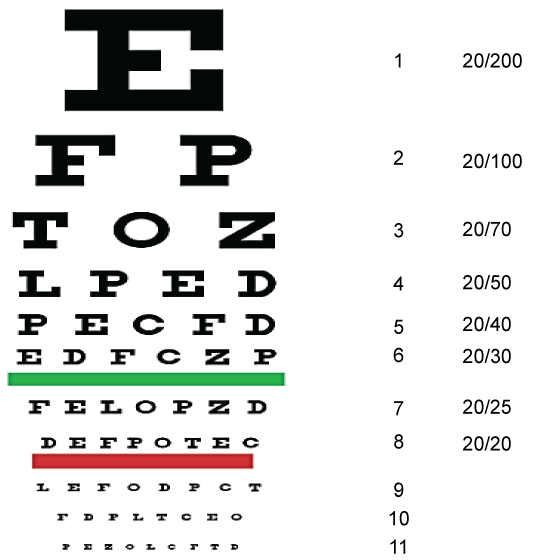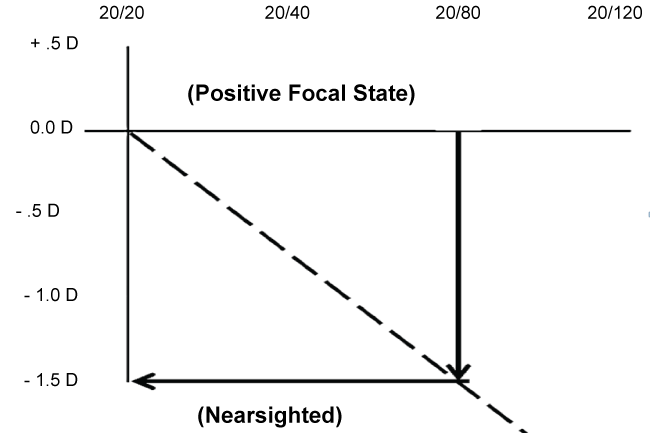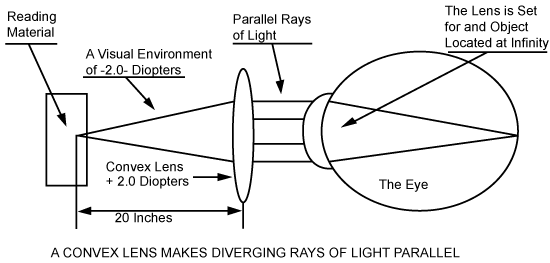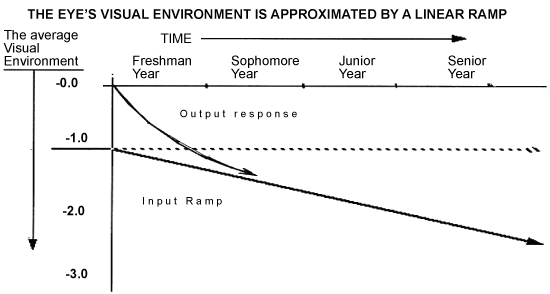Myopia - A Brief Review. Investigation of +2 D. to +3 D. Reading Glasses to Prevent Myopia
Abstract
Basic control theory equations are developed showing classical exponential system response of refraction vs. time R(t), with a characteristic system time constant τ [100 days ± 20%] in response to a negative diopter (-) step change of the student's near-point reading environment. The conclusion is that plus (+) Add lenses, of appropriate strength, +2 D to +3 D, used as reading glasses during study, can prevent the development of myopia progression for college students.
Keywords
Progressive myopia, Reading glasses, Bifocals, Progressive Add Lenses (PALs), Refraction, Myopia prevention, Diopters
Introduction
Literature review
Myopia is a complex, multi-parameter, multi-variable problem, as yet un-solved. In a brief 2,000 words or less review as attempted here, we must be careful not to over-simplify the situation. Myopia per se is more common than the common cold, and likewise, while it is entirely possible to ease the immediate symptoms, basic practical techniques for preventing myopia advancing is still not well established.
Cheng, et al. [1,2] and Gwiazda, et al. and Hyman, et al. [3-5] present a comprehensive listing of modern studies to date in terms of using (+) Add reading glasses to prevent or slow the progression of myopia. Brown & Berger [6], Brown & Young [7], Schaeffel & Howland [9], Medina & Fariza [9], and Greene, Brown, Medina & Graupner [10] use first order control theory to predict myopia development as a function of time. Thorn, Gwiazda & Held [11] present a mathematical model of myopia development using the Gompertz function. Hung & Ciuffreda [12] develop IRDT, incremental retinal defocus, to explain myopia during the growth phase. Medina, et al. [13-15] and Greene & Medina [16-19] use control theory to explain myopia development, solved with digital and analog computer techniques to evaluate first-order equations. Greene & Brown [20] compare theory and experiment for college age students. Fledelius [21] presents data on college graduates and graduate students, showing that the myopia continues to increase from age 21 to 26. Greene, et al. [22] presents data on myopia prevalence and incidence rates over the age range 5 to 30 years.
Figure 1a and Figure 1b below show the near work demand problem, typical of college students, and the proposed optical solution to the problem, namely, custom reading glasses.
The extensive literature on the subject of myopia can be divided into 5 categories, as follows:
1) Medical research [21,23-25]
2) Hereditary research [26-29]
3) Pressure-volume and stress-strain research [30-33]
4) Laboratory and optical research [13,34-36]
5) Epidemiology research [22,37-39]
In this report, various mathematical control theories are reviewed, derived from conventional electrical engineering concepts, as shown in Figure 1c.
When a strong negative step change is made in your visual environment, normal eyes would change their focal state exponentially as shown in Figure 1d. The optical engineering equations as developed here are the same as used to design the focusing system of an auto-focus 35 mm camera, or even the Hubble telescope, whereby the system senses the average environmental distance (in diopters), responding with an equal adjustment of lens power (in diopters).
Figure 1e and Figure 1f shows the correlation between the eye's focal status [diopters] and the Snellen eye chart acuity as measured, from 20/20 to 20/80.
Material and Methods
The Naval Academy requires unaided visual acuity of 20/20 in each eye as a basic entrance requirement. Prospective pilots are required to have normal vision on graduation. A substantial number of midshipmen, entering with 20/20 vision, become myopic during their four years at the Academy. A reasonable assessment of the experimental evidence suggests that the eye sets its long-term focus by a servo control process. This engineering analysis of the eye's control action predicts that a significant percentage of midshipmen could avoid the myopia problem is they wear a convex lens while reading.
A positive lens simulates the effect of a distant object on the eye's accommodation system. Prolonged use of this lens for all close work could prevent the development of myopia in the servo model. This neutralization effect of the positive lens has been experimentally demonstrated during a five-year bifocal study conducted by Oakley and Young [40] (Figure 2a and Figure 2b).
Results
Animals
The controlling variable for this equation is the eye's value of accommodation. The focal settings of the lens is determined by information decoded at the surface of the retina.
The visual environment may be calculated by the use of the equation:
VISUAL ENVIRON = - 1/(OBJECT DIST.) Eq. 6
(in Diopters) (in Meters^-1)
A visual object moved inwards from infinity to one meter constitutes an environment change of -1.0 diopters. Under this circumstance, the accommodation system adjusts the lens by +1.0 diopters to again achieve sharp focus at the surface of the retina.
Average visual environment
The average value of accommodation can be determined if an individual's environment is known on a daily basis. If the individual spends 8 hours outdoors (0 diopters) and 8 hours reading (-3.0 diopters) his average visual environment is -1.5 diopters. The effect of a confined near-point environment can be neutralized or offset by the use of a convex (+) Add lens.
Visual environment of college students
As we enter higher academic institutions, our visual environment gradually shifts to a more negative value, as shown in Figure 3, pertinent to emmetropic plebes (freshmen) at USNA. We can characterize this increased "near" environment by the following ramp function:
A = m t + b, where:
A = Accommodation, daily average value, from the start of the freshman year.
m = -0.001 diopters/day = -0.365 D/yr
t = time in days, b = -1.0 diopters
The Laplace transform of a unit ramp is:
Applying this ramp to the eye's transfer function produces:
The eye's time domain response to a ramp function is [30]:
Discussion
Focal status produced by a plus lens
After two time constants (TAU = 100 days ± 20%), this equation predicts that the eye responds with the same slope as the accommodation ramp. We can logically expect that the eyes of college students potentially drift towards myopia when a linear ramp is applied to their accommodation system.
In a study of the cadets at West Point, Dr. Gmelin determined that freshmen with 20/20 vision and 0 diopters focal state would, after four years, develop 20/80 vision with -1.3 diopters of myopia [41].
A similar study was conducted at the United States Naval Academy by Dr. Hayden, reviewed by Greene, et al. [16]. This study showed an approximately linear change in focal status towards myopia in the eyes of almost all the normal eyed midshipmen [33-36]. Figure 1a shows Norman Rockwell's classic painting "The Law Student", from the 1927 Saturday Evening Post, where the student is seen reading at an effective distance of -3.0 to -4.0 diopters. In order to optically compensate for this near-point demand on the system, a -2.0 to -3.0 D lens is used (Figure 1b).
Myopia prevention
We have plotted the typical college development of myopia as a function of time, as shown in Figure 3a. The dynamic theory explicitly states that the eyes of the USNA midshipmen move into nearsightedness due to their increasingly confined visual environment. Their focal status change is in the right direction and proper magnitude to suggest quantitative verification for this dynamic model of the normal eye's long-term behavior.
Conclusion
Work done during the past twenty years has demonstrated that the accommodation system is a superb example of a physiological control system. It is a complex, sophisticated, and accurate system. We can logically expect that the normal eye is similarly competent in the design of its long-term control system.
Appendix I addresses electrical engineering control systems theory, in terms of predicting myopia progression rates <R> [diopters/year], directly related to the intrinsic emmetropization characteristics of each individual. This is a matter of transforming the exponential emmetropization trajectory to the linearized progressive myopia trajectory.
A number of these stated predictions have been tested(+). Myopia prevention is a very difficult task to accomplish. This report hopefully demonstrates that effective myopia prevention is a reasonable expectation, provided the plus lens is assiduously used for all close work [43].
Acknowledgements
Partial support for this work was provided by NIH NEI Grant EY 005013 at the Depts. of Biomedical Engineering and Ophthalmology at Johns Hopkins University. The author would like to thank Otis Brown, Frank Young, David Guyton, Brian Curtin, William Baldwin, Antonio Medina, Karel Montor, and Sterling Colgate for many helpful discussions.
References
- Cheng D, Woo GC, Drobe B, et al. (2014) Effect of bifocal and prismatic bifocal spectacles on myopia progression in children: three-year results of a randomized clinical trial. JAMA Ophthalmol 132: 258-264.
- Cheng D, Woo GC, Schmid KL (2011) Bifocal lens control of myopic progression in children. Clin Exp Optom 94: 24-32.
- Gwiazda J, Hyman L, Hussein M, et al. (2003) A randomized clinical trial of progressive addition lenses versus single vision lenses on the progression of myopia in children. Invest Ophthalmol Vis Sci 44: 1492-5000.
- Hyman L, Gwiazda J, Hussein M, et al. (2005) Relationship of age, sex, and ethnicity with myopia progression and axial elongation in the correction of myopia evaluation trial. Arch Ophthalmol 123: 977-987.
- Scheiman M, Zhang Q, Gwiazda J, et al. (2014) Visual activity and its association with myopia stabilisation. Ophthalmic Physiol Opt 34: 353-361.
- Otis Brown, Ron M Berger (1979) A Nearsightedness Computer, Proceedings of the Annual New England Bioengineering Conference, 343-346.
- Brown OS, Young FA (1981) The response of a servo controlled eye to a confined visual environment. Biomed Sci Instrum 17: 41-44.
- Schaeffel F, Howland HC (1988) Mathematical model of emmetropization in the chicken. J Opt Soc Am A 5: 2080-2086.
- Medina A, Fariza E (1993) Emmetropization as a first-order feedback system. Vision Res 33: 21-26.
- Greene PR, Brown OS, Medina AP, et al. (1996) Emmetropia approach dynamics with diurnal dual-phase cycling. Vision Res 36: 2249-2251.
- Thorn F, Gwiazda J, Held R (2005) Myopia progression is specified by a double exponential growth function. Optom Vis Sci 82: 286-297.
- Hung GK, Ciuffreda KJ (2007) Incremental retinal-defocus theory of myopia development-schematic analysis and computer simulation. Comput Biol Med 37: 930-946.
- Medina A (2015) The progression of corrected myopia. Graefes Arch Clin Exp Ophthalmol 253: 1273-1277.
- Medina A, Greene PR (2015) Progressive Myopia and Lid Suture Myopia are Explained by the Same Feedback Process: a Mathematical Model of Myopia. J Nat Sci 1: e121.
- Medina A (2016) Detecting the effect of under-correcting myopia. Graefes Arch Clin Exp Ophthalmol 254: 409-410.
- Greene PR, Grill ZW, Medina A (2016) Mathematical Models of College Myopia. Optik (Stuttg) 127: 896-899.
- Peter R Greene, Antonio Medina (2016) Analogue Computer Model of Progressive Myopia-Refraction Stability Response to Reading Glasses. J Comput Sci Syst Biol 9: 104-105.
- Peter R Greene, Antonio Medina (2016) The Progression of Nearwork Myopia. Optom Open Access 1: 120.
- Peter R Greene, Zachary W Grill, Antonio Medina (2015) Exploring Reading Glasses to Stabilize College Myopia. JSM Ophthalmol 3: 1034.
- Greene PR, Brown OS (2017) REVIEW. +2 to +3 D. Reading Glasses to Prevent Myopia. EC Ophthalmology 5: 11-27.
- Fledelius HC (2000) Myopia profile in Copenhagen medical students 1996-98. Refractive stability over a century is suggested. Acta Ophthalmol Scand 78: 501-505.
- Greene PR, Greene JM (2017) Advanced myopia, prevalence and incidence analysis. Int Ophthalmol.
- Scnmid K (2017) "The Myopia Manual".
- Spaide RF, Ohno-Matsui K, Yannuzzi LA (2014) Pathologic myopia. Springer, New York.
- Curtin BJ (1985) The myopias. Basic science and clinical management. Harper & Row, Philadelphia, USA, 495.
- Greene PR, Medina A (2016) Refraction data survey: 2nd generation correlation of myopia. Int Ophthalmol 36: 609-614.
- Bartsocas CS, Kastrantas AD (1981) X-linked form of myopia. Human Heredity 31: 199-200.
- Olavi Pärssinen, Markku Kauppinen, Anne Viljanen (2014) The progression of myopia from its onset at age 8-12 to adulthood and the influence of heredity and external factors on myopic progression. A 23‐year follow‐up study. Acta Ophthalmologica 92: 730-739.
- Zhang Q, Guo X, Xiao X (2006) Novel locus for X linked recessive high myopia maps to Xq23–q25 but outside MYP1. J Med Genet 43: e20.
- Purslow PP, Karwatowski WS (1996) Ocular Elasticity: is engineering stiffness a more useful characterization parameter than ocular rigidity? Ophthalmology 103: 1686-1692.
- Peter R Greene, Nikolai M Sergienko, Sean K Wang (2016) Review: Measurement Techniques for Intraocular Pressure. Optometry Open Access.
- Ethier CR, Johnson M, Ruberti J (2004) Ocular biomechanics and biotransport. Annu Rev Biomed Eng 6: 249-273.
- Reno Genest, Naveen Chandrashekar, Elizabeth L Irving (2013) Finite Element Model of the Chick Eye to Study Myopia. Journal of Medical and Biological Engineering 33: 215-220.
- Ho Arthur, Smith III Earl Leo, Sankaridurg Padmaja, et al. (2010) Method and apparatus for controlling peripheral image position for reducing progression of myopia.
- Smith EL, Hung LF, Huang J (2012) Protective effects of high ambient lighting on the development of form-deprivation myopia in rhesus monkeys. Invest Ophthalmol Vis Sci 53: 421-428.
- Goss DA, Criswell MH (1981) Myopia development in experimental animals-a literature review. Am J Optom Physiol Opt 58: 859-869.
- Greene PR, Vigneau ES, Greene J (2015) Exponential prevalence and incidence equations for myopia. Clin Exp Optom 98: 210-213.
- Brien A Holden, Timothy R Fricke, David A Wilson, et al. (2016) Global prevalence of myopia and high myopia and temporal trends from 2000 through 2050. Ophthalmology 123: 1036-1042.
- Peter R Greene, Judith M Green (2016) Prevalence and incidence of myopia and high myopia. New Front Ophthalmol 2: 1-4.
- Oakley KH, Young FA (1975) Bifocal control of myopia. Am J Optom Physiol Opt 52: 758-764.
- Gmelin RT (1976) Myopia at West Point: past and present. Mil Med 141: 542-543.
- Goss DA (1987) Linearity of refractive change with age in childhood myopia progression. Am J Optom Physiol Opt 64: 775-780.
- Hung LF, Crawford ML, Smith EL (1995) Spectacle lenses alter eye growth and the refractive status of young monkeys. Nat Med 1: 761-765.
Corresponding Author
Peter R Greene, Ph.D., BGKT Consulting Engineers Ltd, Bioengineering, Huntington, New York, 11743, USA, Tel: +1-631-935-5666.
Copyright
© 2017 Greene PR, et al. This is an open-access article distributed under the terms of the Creative Commons Attribution License, which permits unrestricted use, distribution, and reproduction in any medium, provided the original author and source are credited.

